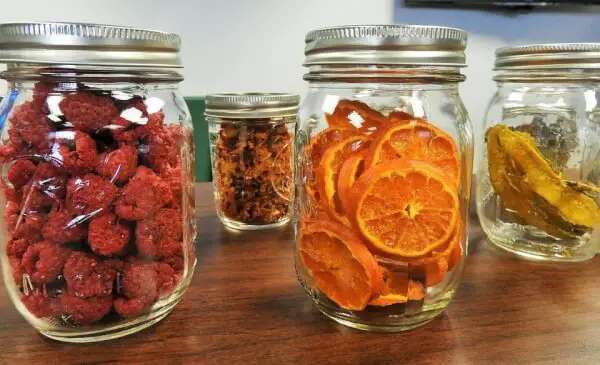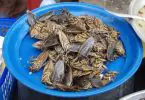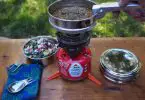When it comes to cuisine at the campsite, nothing beats dehydrated food. Lightweight, convenient, and space-saving, dehydrated food is the way to serve actual meals in the wilderness instead of relying on a cobbled-together (and unsatisfying) food pyramid of granola bars and trail mix.
If you’re a serious outdoor adventurer, purchasing a food dehydrator is a wise investment. It allows you to plan ahead and prepare rations for several meals at a time, enabling you to pack healthy foods and avoid spending piles of cash for store-bought dehydrated goods.
Once you experience how delicious, convenient, and healthy dehydrated food can be, you’ll never resort to a granola bar dinner again. To get your appetite and imagination kickstarted, we’re going to share some tried-and-true dehydrated meal recipes guaranteed to satisfy every hungry mouth in your pack when mealtime arrives on the trail.
Advantages of Dehydrated Food
If the concept of dehydrated food still sounds unappealing (or strictly suited for astronauts), stay with us: there are a whole host of good reasons to dehydrate your menu:
Convenience
By putting some advance thought into your meal planning before you pack up for the trail, you can piece together some fabulous food that future-you will be extremely grateful to gobble up…and all you’ll have to do is open the packages, rehydrate, and serve. It doesn’t get easier than that.
Nutrition
Food dehydrators can successfully dry a whole host of fruits, beans, and vegetables while maintaining their inherent nutritional value — something that is of utmost importance after long, strenuous, and physically demanding days on the trail.
You’ve got no room for junk when you’re asking your body for top performance. Also, when you dehydrate your own food, you can leave out the additives and preservatives often found in store-bought dehydrated goods.
Trail-friendliness
No one wants to lug heavy cans, boxes, or bags of food in their pack, only to have to deal with the bulky refuse after the meal is prepared. Dehydrated meals are lightweight and take up minimal space, and the leftover trash weighs virtually nothing.
Budget-friendliness
Drying and preparing your own food for the trail is extremely cost effective. You can get several meals out of a surprisingly affordable amount of food, whereas store-bought freeze-dried meals can run you nearly $10 a pop.
Customization
If you or a member of your trail trekking team has dietary restrictions (or is just a picky eater), you can easily take that into account when planning and dehydrating your own rations.
Since you’re packing the ingredients, you know exactly what is and isn’t in the food, so no extra thought has to be put into mealtime when it’s time to dig in.
Creativity!
Who would’ve thought you could have freshly prepared curry on the trail? Or tender, perfectly seasoned couscous? Or your favorite spicy pasta dish? Dehydration makes all these meals possible…and that’s just the beginning!
See also: Best Hiking Snacks: Fuel Yourself on the Trail With These Delicious Treats
When you become familiar with your dehydrator and your personal campground cooking skills, you can branch out into all sorts of cuisines and original recipes. You’ll probably stumble upon a few home runs that will become your go-to staples every time you eat al fresco.
Now that we’ve sold you on the unbeatable value and versatility of dehydrated food, let’s dig in to some delicious dehydrated meal recipes to get you started!
Ramen! Ramen! Ramen!
Yes, that old broke-college-student favorite is a natural choice when it comes to cooking on the trail, but you can forget all about that little silver packet of powdery flavoring that comes with each brick of noodles.
Plain ramen is a fantastic base for all sorts of satisfying meals; add water, dehydrated veggies, and a bouillon cube for a quick and hearty soup, or dehydrated scallions, red pepper flakes, and a packet of peanut sauce for a tasty Thai twist.
A packet of miso paste with some dehydrated onions and tofu cubes can cook up a tasty vegan option as well. Ramen cooks up fast with very little moisture, so it’s a great choice when time is of the essence, but your belly is begging for a filling meal.
And, of course, if you really like that little square of seasoning powder that comes packaged with the noodles…what the heck — knock yourself out. For more lunch ideas you can try, check out our earlier piece to find out.
Curries
Serving a curry at the campsite might seem complicated or downright exotic, but curries are a quick and easy way to prepare lots of filling ingredients bound together by an irresistibly savory sauce. Food dehydrators can dry sauces such as red curry paste into a leather, making it easy to stow and go until it’s time for dinner.
Combining curry paste leather with dehydrated veggies (pumpkin, sweet potato, and/or green beans are winners here) and some coconut milk powder will cook up a hearty curry in no time, which you can serve over a bed of (formerly dehydrated) rice.
Adding curry-friendly chick peas will also provide a nice boost of protein while still keeping the dish meat-free, and some dehydrated pineapple is a great way to add a little sweetness.
While not technically a curry, Indian Tikka Masala sauce-turned-leather is another alternative sauce that works well with a variety of veggies, as well as lentils and chick peas. Curries and rich sauces like Tikka Masala are especially satisfying for those cold weather hikes, when nothing feels better at the end of a long day than a belly full of warm, spicy food.
Perfect Pasta
Carbs are always tempting after a long day of outdoor activity, and there’s certainly nothing wrong with digging into a big old bowl of starchy goodness…but when you’ve got dehydrated food at the ready, you can balance out all those noodles with some vegetables and protein.
Think pasta primavera when you go for the noodles, and with the help of some oil or some tomato sauce leather, you’ll end up with a dish packed full of spinach, broccoli, zucchini, eggplant, tomatoes, peppers, and onions, which you can top with some packets of red pepper flakes and non-refrigerated parmesan cheese.
You can also go full-on carbonara with some peas, bacon bits if you’re into meat (the real bacon kind, not the fake kind), and powdered cream sauce that can be whipped together for a rich alfredo topping.
You can also alter your alfredo by replacing the peas with spinach and diced red pepper and the bacon bits with pine nuts for a creamy, flavorful sauce without the meat. Be sure to pack a small bag of freshly cracked black pepper to easily give these cream sauces an extra kick of flavor and some gourmet flair.
If you’ve got younger adventurers in your group, pick a pasta that comes in a fun shape, along with a basic tomato-basil sauce leather. You can sneak some extra veggies into this dish by dehydrating small cubes of peppers, carrots, and onions along with finely chopped spinach which will disappear into the sauce and likely go unnoticed by hungry little mouths.
But if those veggies won’t pass the picky-eater test and you just need to get food in bellies, you can also opt for the simpler kid favorite of buttered noodles, with a couple packets of non-parmesan cheese on hand to give it a bit of extra flavor. If you’re concerned about nutritional value, make sure to use high-fiber, whole grain pasta, or noodles made with vegetable puree to balance out the carb-heavy aspect of the meal.
Cuckoo for Couscous
Couscous is another all-out winner when it comes to campground cooking. It’s quick to cook and makes a filling base for all sorts of veggies and protein. You can whip up a quick Mediterranean style couscous with dehydrated tomatoes, lentils, onions, and some dried parsley, oregano, and a hint of mint, tossed together with a little oil and a couple packets of lemon juice.
Another creative and filling way to prepare couscous is to give it a Tex-Mex flair: cook your couscous with some dehydrated peppers, carrots, corn, lentils, and black beans, then add in some cumin or powdered taco seasoning with a bit of chicken bullion if desired. Chick peas are another great addition here for an extra protein boost.
Getting Nice with Rice
It’s hard to beat dehydrated rice as a versatile foundation for an array of tasty recipes — both sweet and savory. It’s also a fantastic gluten-free option if you find yourself needing to plan around that particular restriction.
A basic rice-and-veggies dish can be spiced up in a variety of ways; rice with carrots, corn, broccoli, and peas can be seasoned with soy sauce packets or miso paste, crumbled dried seaweed, red pepper flakes, and some red pepper oil (along with a chicken or veggie bullion cube, if desired).
You can also toss your rice and veggies in butter and parmesan cheese for a milder flavor, adding in a little garlic salt and black pepper to taste. Lemon pepper seasoning is also great to have on hand to add some tangy flavor to your veggies.
Dehydrated short grain rice can also be used to create a quick risotto. Add in some dehydrated porcini mushrooms, vegetable stock, and butter or oil to whip up a creamy and satisfying dinner on a chilly night.
You can also combine the rice with dehydrated tomatoes, tomato sauce leather, and parmesan cheese for a brighter flavor. Dehydrated spinach works nicely as an addition to both of these preparations.
Rice can also be used for after-dinner dessert duty: combine dehydrated rice with milk powder, dried fruit, some sugar (brown or white), and some cinnamon and/or dried coconut. Add boiling water and let the mixture sit until the rice cooks. Shake occasionally to stir, and soon you will have a sweet rice dessert to enjoy around the campfire.
Oatmeal with Options
Oatmeal is a natural choice for the trail with its well known just-add-water capability, but with the help of some dehydrated fruit, you can dress it up like never before.
Start with a plain or flavored variety, and add in some dehydrated berries, cherries, mango, bananas, coconut flakes, and/or peaches with some diced walnuts and drizzle with a packet of honey or maple syrup. You just upgraded that sad little packet of dried oats to a brunch-worthy delight.
Pudding it out There
Terrible word play aside, pudding is a great choice for a trailside treat, and you can make it a bit healthier by adding in some dehydrated fruit and sprinkling on some chia seeds or flax seeds. You’ll need to use powdered milk instead of fresh milk, naturally, but with that one small adjustment you’ll be enjoying a rich dessert that makes a perfect ending to your meal.
Pudding and fruit combinations that work well are chocolate pudding with strawberries, vanilla pudding with peaches and/or bananas, and—getting a little crazy here—banana-flavored pudding with strawberries. If you can find it, creamy coconut pudding is delicious with dehydrated mango and pineapple.
Final Thoughts
Even if you’re not usually enamored with cooking in the comfort of your own kitchen, there is a certain novelty and creativity involved in campground cooking that adds a bit of excitement and fun to food preparation.
And with the use of a good food dehydrator—and with a basic knowledge of food science and what flavors and textures play well together—there is virtually no limit to the recipes you can create to bring your own gourmet flair to your meals on the trail.
And even if the thought of open-air cooking doesn’t excite you in the slightest, you can at least enjoy the wide variety of foods that dehydrators allow you to bring along on your adventures. From curries to veggies to rich pastas and creamy, irresistible desserts, food al fresco has come a long way from cracking open a can of beans over a crackling campfire.
Are you a seasoned campground gourmet? Are you new to food dehydration? Do you have some favorite recipes you’d love to share with your fellow outdoor adventurers? Share your thoughts, comments, and recipes with us in the comments!
No time to cook? Why not take a look at our must-read article on no-cook camping meals for more insight.
Featured Image Source: https://pixabay.com/photos/mason-jars-dehydrated-fruit-oranges-2742757/








